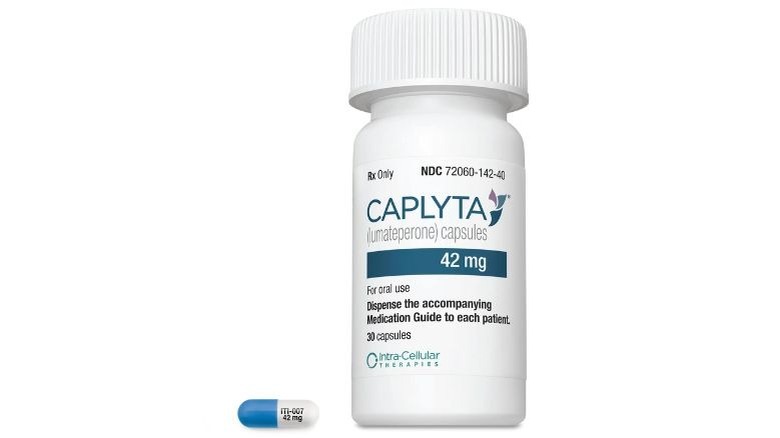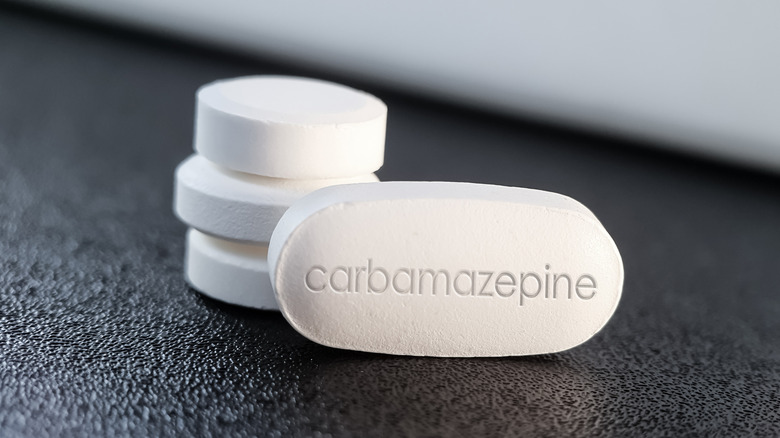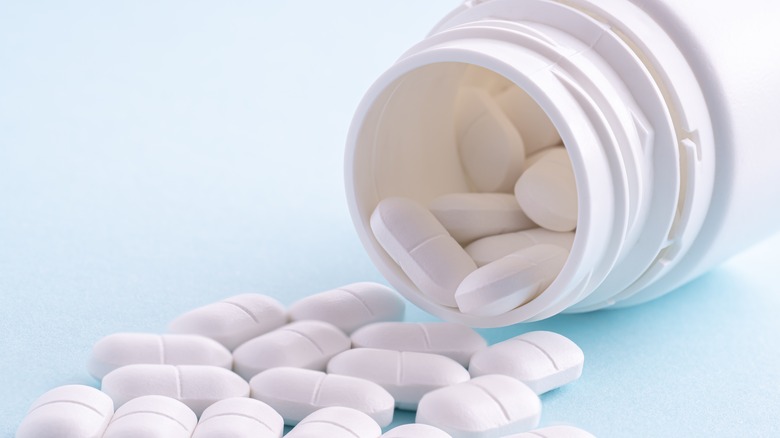The Caplyta Commercial Explained: Drug Uses, Side Effects, And More
You've probably seen the commercial for the drug Caplyta which is supposed to help with depressive symptoms of bipolar I and bipolar II. Featuring mostly young adults, the advert starts off by saying that with the drug, "there's a chance to let the light shine through." Curious about the commercial and what this drug is all about? Read on to find out its uses, side effects, dosage, precautions, and more.
Depression is one of the main symptoms of the mental health conditions bipolar I and bipolar II disorders. They are two of a few different types of bipolar and related disorders. Formerly referred to as manic depression, bipolar disorder is characterized by extreme mood swings — extreme highs and extreme lows. It is a lifelong condition and managing symptoms is a big part of the treatment. Bipolar disorder is usually diagnosed when someone is in their teen years or early 20s, but it can occur at any age.
If you or someone you know needs help with mental health, please contact the Crisis Text Line by texting HOME to 741741, call the National Alliance on Mental Illness helpline at 1-800-950-NAMI (6264), or visit the National Institute of Mental Health website.
What is Caplyta and what does it do?
Caplyta (pronounced: kap-lite-uh) is the brand name for the prescription drug lumateperone and is manufactured by the biopharmaceutical company Intra-Cellular Therapies, Inc. It's used to treat schizophrenia and depressive symptoms arising from bipolar I and bipolar II. Lumateperone belongs to a class of drugs called atypical antipsychotics which basically means that there's less of a chance of side effects with this drug than older antipsychotics.
While the exact way the drug works is unknown, it is thought to influence different brain-signaling chemicals (central serotonin 5-HT2A receptors and central dopamine D2 receptors) and balance these natural substances in your brain. Both bipolar disorder and schizophrenia are associated with imbalances of brain chemicals. It may take a week for the drug to start working once you take it and a few more weeks before you start to see changes in your symptoms.
U.S. Food and Drug Administration (FDA) approval for Caplyta came in 2019, although at the time, the drug was approved for the treatment of schizophrenia in adults. It was approved for bipolar disorder in 2021. Caplyta is a brand-name medication and isn't available in its generic form yet. It is not used to treat mental health symptoms in children.
Caplyta side effects
The side effects of this drug range from mild to severe. Sleepiness, dizziness, nausea, and dry mouth are the most common.
More severe side effects include stroke, neuroleptic malignant syndrome (NMS), problems with your metabolism, low white blood cell count, low blood pressure (orthostatic hypotension), increased risk of falls and injuries, seizures, fatigue and concentration issues, problems with regulating body temperature, overheating, and difficulty swallowing. Although the commercial notes that weight gain and movement disorders like akathisia were not commonly associated with the drug in clinical trials, changes in your metabolism caused by antipsychotic medications like Caplyta could cause weight gain in some. The drug is also known to cause tardive dyskinesia or TD (uncontrolled body movements) in your face, tongue, or other body parts, so run these concerns by your healthcare provider. Headaches could be a side effect too.
If you have any underlying health conditions like high or low blood pressure, cardiovascular issues, stroke, diabetes, liver or kidney problems, it's important that you discuss these with your healthcare provider before taking the drug. Fertility issues in both men and women are also a possibility when you're on Caplyta.
This, however, is not an exhaustive list of all the possible side effects. For a complete list and explanations, visit the company website.
Caplyta dosage
One pill, once a day, taken with or without food is the company recommendation. The drug comes as a capsule and has three strengths — 42 milligrams, 21 milligrams, and 10.5 milligrams. Your doctor will prescribe the dosage including the strength of the capsule you should be taking. Typically, the drug is taken as a long-term treatment. While the drug starts working immediately, as we said before, it may take a few days for brain chemicals to be influenced and for you to see results.
Missing a dose may mean that you either take it as soon as you remember it or skip it and resume with your next dose. This is also a question for your healthcare provider. Try and keep to a consistent time each day when taking your pills. For example, if you take the capsule in the afternoon, keep taking it in the afternoon always. Sometimes, your doctor may prescribe that you take Caplyta with other medications like lithium (Lithobid) or valproate, particularly in cases when it's being recommended for treating depressive symptoms related to bipolar disorder. Lithobid and valproate are prescribed for the manic symptoms associated with this mental health condition.
It is important to follow the exact dosage instructions prescribed by your doctor when consuming Caplyta. Do not change the dosage. Overdosing on the drug can have serious consequences. Call your doctor or the Poison Control Center at 1-800-222-1222 right away if this happens. Store the drug at room temperature between 68 degrees Fahrenheit to 77 degrees Fahrenheit.
Caplyta precautions
According to the company website and the commercial, the drug is not approved for treating psychosis in people with dementia. In fact, it could increase the risk of death in elderly people with psychosis and dementia. The manufacturers further highlight that Caplyta and antidepressant medications could worsen suicidal thoughts in children, adolescents, and young adults, especially when the dosage is altered.
Further precautions that come with the use of this drug have to do with allergies to any of its ingredients. Each capsule contains the active ingredient lumateperone and inactive ingredients croscarmellose sodium, gelatin, magnesium stearate, mannitol, and talc. They also contain colorants like titanium dioxide. Symptoms of an allergic reaction to the drug include rash, itching, hives, and a swollen tongue, lip, face, or throat. Get immediate medical help if symptoms show up.
Lumateperone could affect how much you sweat so make sure you're hydrating enough, staying out of the heat, and not doing anything too strenuous to induce overheating. If you're pregnant or nursing a newborn, consult with your doctor about the side effects associated with consuming lumateperone. The drug could pass on to a newborn via breast milk and cause symptoms (although rare) like breathing difficulties, muscle stiffness, and constant crying. Since one of the side effects of the drug is drowsiness or dizziness, it is recommended that you avoid consuming alcohol or marijuana while on the drug. Anything that requires alertness like driving and operating machinery should also be discussed with your doctor when you're on this drug.
If you or someone you know is struggling or in crisis, help is available. Call or text 988 or chat 988lifeline.org
Avoid taking Caplyta if you are on these medications
It's important to discuss your complete medical history and whatever other medications you're on with your healthcare provider because lumateperone could interact unfavorably with some medications and vice versa. Other prescription medications you're on, vitamins, and herbal supplements should all be made transparent to your doctor. Do not stop or start any of the medications you're taking without discussing it with your doctor.
The list of possible medications that could interact with Caplyta includes:
- Some seizure medications like phenytoin (Dilantin) and carbamazepine (Tegretol)
- Certain antibiotics like rifamycins (Rifabutin), ciprofloxacin (Cipro), erythromycin (Eryc), and clarithromycin
- Diltiazem (Cardizem), verapamil (Verelan), and other heart medications
- Opioids
- Cough medications like codeine and hydrocodone
- Sleep or anxiety pills like alprazolam, lorazepam, and zolpidem
- Muscle relaxants such as carisoprodol and cyclobenzaprine
- Antihistamines (think cetirizine and diphenhydramine)
- The tuberculosis drug rifampin (Rimactane)
- The nausea pill aprepitant (Emend)
This is not a complete list of possible medications that could interact with the drug. Your healthcare provider will be able to give you a better idea of other medications that make the list.
How much does Caplyta cost?
The wholesale acquisition cost (WAC) or list price of the drug (which is not reflective of the price patients or insurers pay) is $55.39 per Caplyta capsule and $1,661.75 per bottle. The price could change depending on where you live, your insurance coverage, and the pharmacy you frequent.
According to the company website, 93% of Americans have insurance coverage for the drug. For those with Medicaid and Medicare Part D, the medication is covered for more than 99% of people. It is possible that you might require prior authorization from your insurance company so discuss this with your healthcare provider and insurance company. You could get a 90-day supply if the coverage is approved.
You can also check out Medicare's Extra Help program to see if you're eligible. You could automatically qualify if you've signed up for both Medicare and Medicaid, you're older than 65 years and you're on Medicaid, you're receiving a supplemental security income via the Social Security Administration, or you belong to the Medicare Savings Program.
Caplyta vs. Vraylar: What's the difference between the two?
Vraylar (brand name) is another prescription drug that is used to treat schizophrenia and symptoms associated with some kinds of bipolar disorder, particularly bipolar 1 disorder. Additionally, this drug is also prescribed alongside antidepressant medications to treat major depressive disorder (MDD), a mood disorder that results in persistent feelings of sadness and lack of interest. The active ingredient in the drug is cariprazine. Like lumateperone, cariprazine is an atypical antipsychotic and is only available under the brand name.
The boxed warnings of Vraylar are very similar to that of Caplyta — suicidal thoughts and behaviors in young adults and children and increased risk of death in older people with dementia psychosis. Common side effects include slow movements, difficulty moving, tremors, uncontrolled body movements (tardive dyskinesia or TD), restlessness, sleepiness, trouble sleeping, nausea, vomiting, indigestion, constipation, fatigue, increased appetite, and dizziness. The drug also poses a risk of stroke, NMS, problems with your metabolism characterized by high blood sugar, increased cholesterol and triglycerides in your system, and weight gain. Difficulty swallowing, increased risk of falls and injuries, low white blood cell count, seizures, and an increase in body temperature are additions to the drug's list of serious side effects.
Like Caplyta, Vraylar could also cause allergic reactions in some people who might be sensitive to some or all of the ingredients in the capsule. Apart from cariprazine, Vraylar contains gelatin, magnesium stearate, pregelatinized starch, titanium dioxide, and other colorants.







